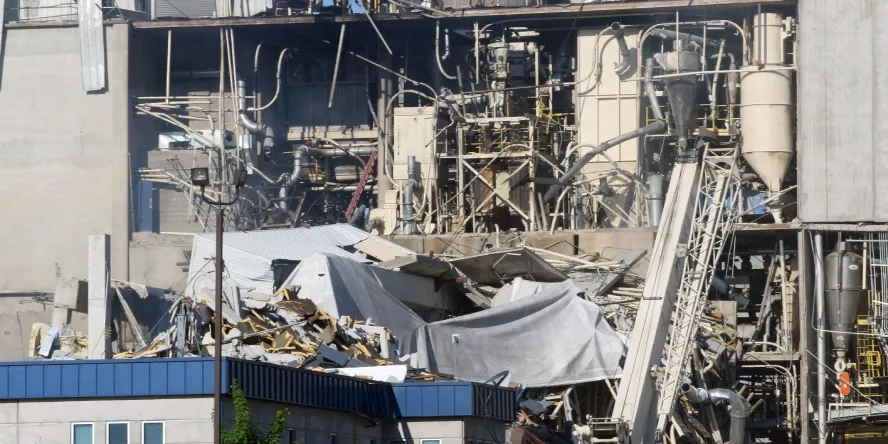The dust explosion at the mill claimed five lives and destroyed 4 of 9 buildings. A further 5 were very badly damaged.
The Didion Milling Plant corn processing facility was ordered to pay over PLN 6.5 million in fines (over $1.8 million) as a result of a corn dust explosion that killed five people and injured 14 others.
The explosion and subsequent fire occurred on May 31, 2017. The disaster resulted in the collapse of 4 of the 9 buildings forming the Didion Milling complex. The other 5 buildings were severely damaged.
WHAT CAUSED THE EXPLOSION?
14 witnesses who survived the disaster were interviewed after the explosion. The main conclusions from their statements can be summarised as follows:
1. some of the workers who smelled smoke began searching for its source,
2. the vast majority of people continued to work as normal – they were unaware that anything was wrong,
3. the source of the smoke, a gap mill located in building B, was located only around 15 to 30 minutes before the explosion,
4. one of the witnesses who reached the mill in question saw an air filter be torn off from a stub pipe of the pneumatic transport system used to transport milled product from the mill to the cyclone dust collector as a result of an explosion inside the device (see illustration below),
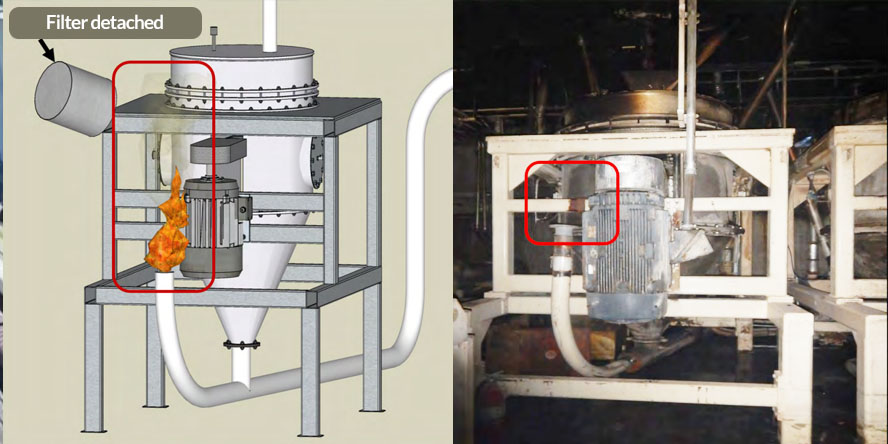
The gap mill with the pneumatic transport system transferring ground corn to the cyclone – this is the installation where the disaster started (located in building B).
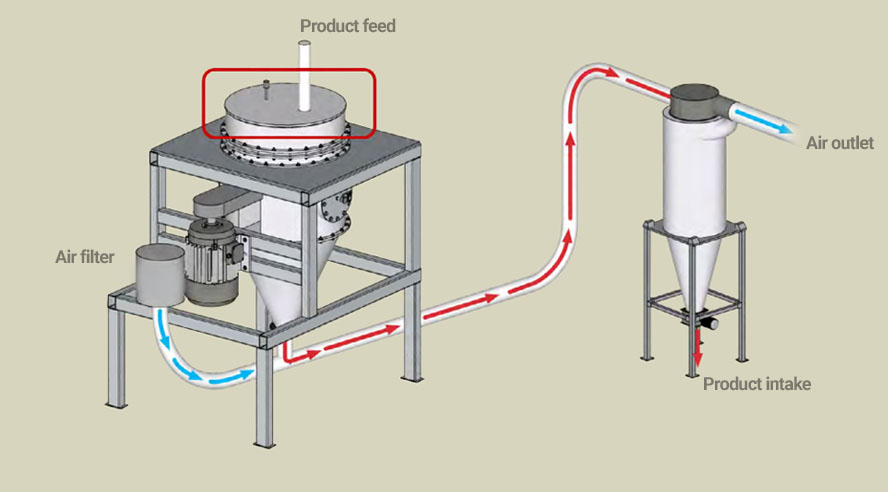
The gap mill where the first explosion occurred and the cyclone receiving the ground product.
5. apart from the torn off filter, he also saw dust and/or smoke escaping from the upper part of the mill (see the red frame in the above illustration) and flames billowing from the above-mentioned stub pipe. The fire was visible for a few seconds, then was sucked into the installation. After a short while, however, it was forced out again.
6. it was possible for the air filter to be torn off because the mill was not equipped with explosion protection, in particular so-called ‘explosion containment’, which would have allowed containing the effects of the explosion to the inside of the mill,
7. employees wanted to turn off the damaged mill – unfortunately, when they managed to do it, another explosion took place,
8. airborne corn dust ignited and a series of secondary explosions took place. As a result, 4 of the 9 buildings forming the Didion Milling complex collapsed. The other 5 buildings were severely damaged.
9. five workers were killed in the explosions and the collapse of the buildings, 14 suffered injuries of varying severity (19 people were working at the plant at the time of the explosion).
A video showing the aftermath of the blast
VIDEO – CATASTROPHIC EFFECTS OF CORN DUST EXPLOSION
The video above (click the icon to be taken to the video page) shows several shots of the plant immediately after the explosion. They show destruction on a shocking scale. According to a representative of Occupational Safety and Health Administration (OSHA), Didion Milling could have prevented this tragedy if only it had acted on the hazards that are well known in the industry. Instead, regulations were disregarded, leading to an explosion that claimed the lives of several people…
CAUSES OF THE DISASTER
Based on available materials – including photographs, witness statements, and a 2011 OSHA report that identified deficiencies and inadequacies in the area of safety – we can pinpoint the major causes of this enormous disaster with a high degree of certainty:
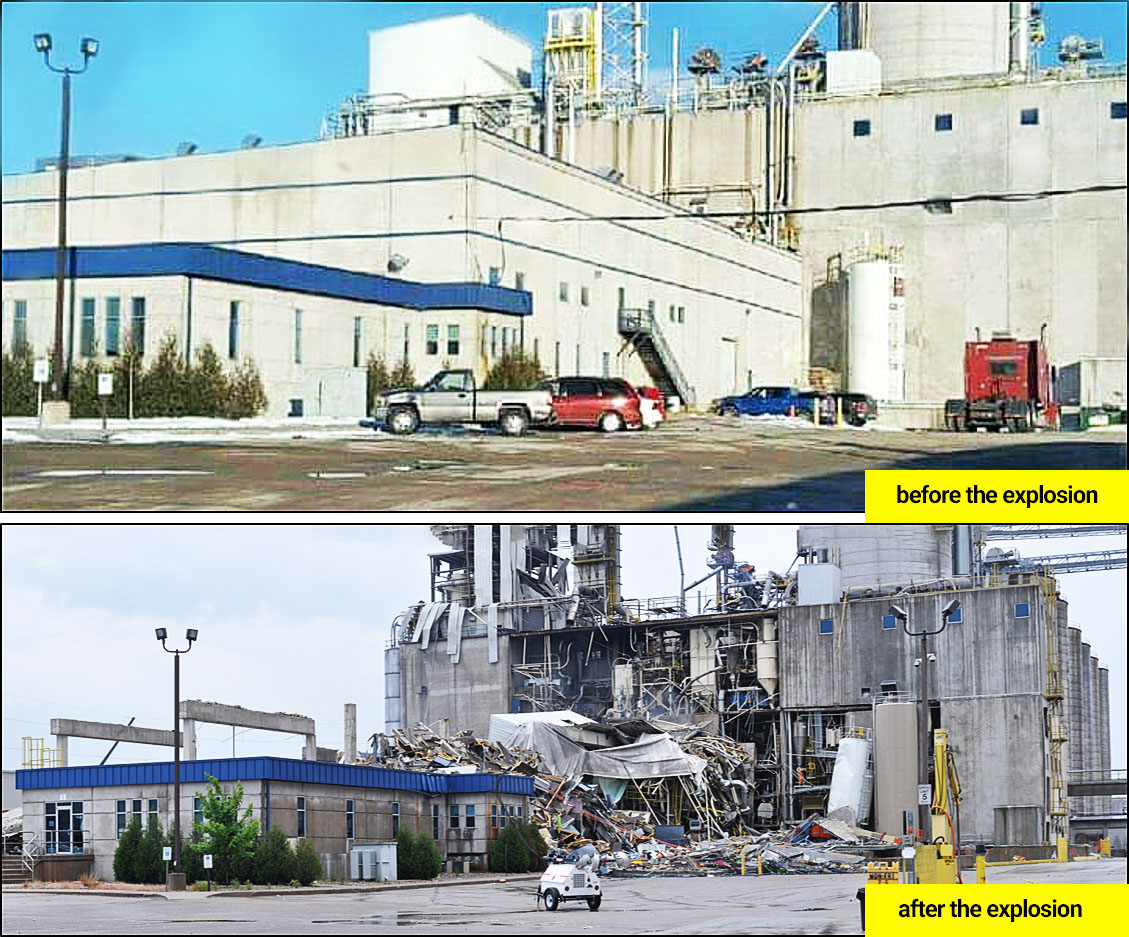
1. large quantities of dust deposited across the plant (caused by issues such as leaking installations and ineffective dust extraction systems),
2. lack of procedures for the removal of deposited dust and lack of training in this area (for example, employees used compressed air to clean the dust up, which was a cardinal error that led to the formation of explosive atmospheres),
3. deficiencies in the area of explosion protection – if the mill had been equipped with explosion containment systems, the tragedy would have been avoided (only a few devices were equipped with random safeguards),
4. insufficient fire safety installations (for example, two days before the explosion there was a fire in the fluidization dryer, which was not equipped with an automatic fire suppression system),
5. failure to provide training to staff to raise awareness of hazards present in the plant, potentially leading to an explosion and/or fire.
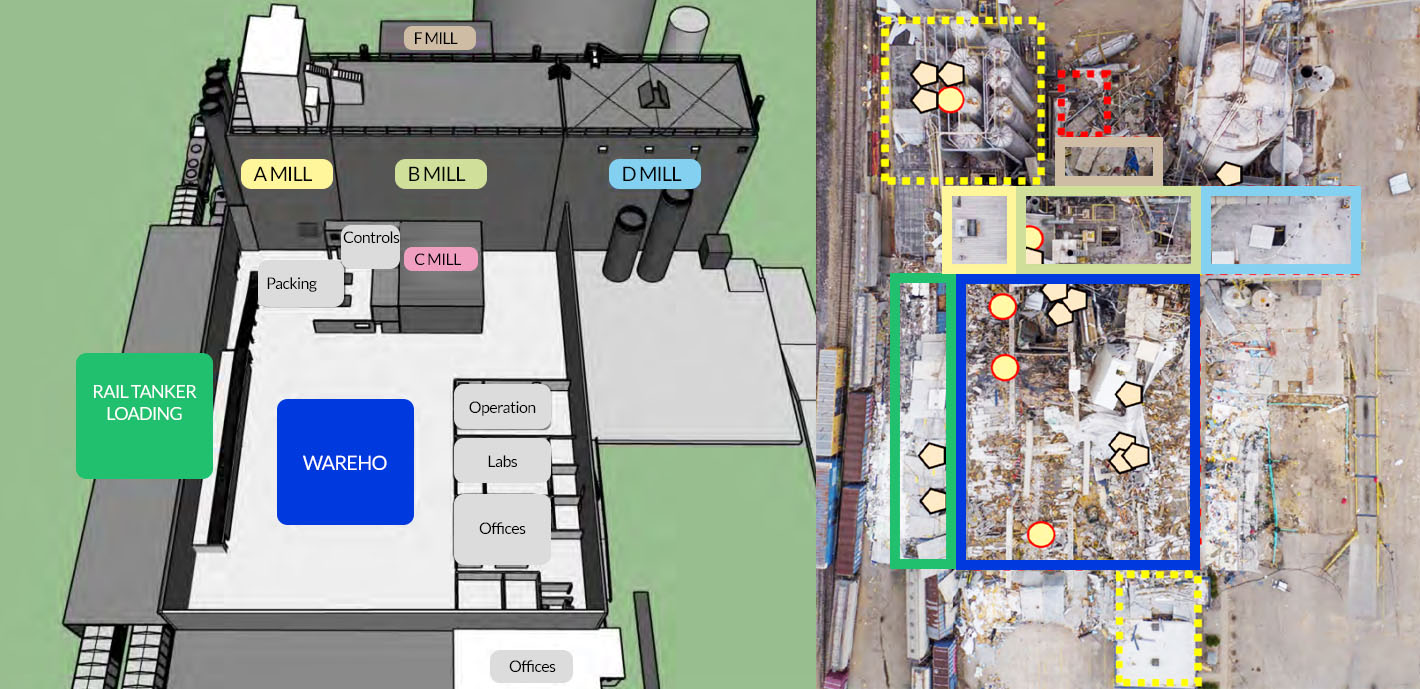
On the left is a visualization of part of the plant before the explosion. The mill was located in the ‘B MILL’ building. On the right is an actual photo of the plant after the explosion, with superimposed outlines of the buildings and approximate locations of workers at the time of the explosion (pentagons – fatalities; circles – injuries).
HOW COULD THIS HAVE BEEN AVOIDED?
Ensuring safety always begins with prevention. In this case, the source of ignition that initiated the primary explosion at the mill is unknown. However, based on our experience, the most common causes of explosions include:
1. presence of a foreign object (a rock, rod, screw, etc.) in the milling chamber, causing sparking or friction,
2. poor condition of the device, which also results in mechanical sparking or friction of internal components of the device.
Eliminating potential ignition sources is crucial, but there is no way of ensuring that all such hazards will be eliminated. A very similar incident took place in Poland, where the explosion was caused by a screw. The screw found its way into the mill despite the fact that the installation was equipped with as many as two magnetic separators, which theoretically should have caught it.
How can we then avoid similar incidents? This is a subject that could fill an entire book.
A (PARTIAL) ANSWER AS A REWARD FOR YOUR PERSEVERANCE
If you’ve made it this far, you’re either persistent or you’re struggling with a similar problem… or possibly both. That’s why we’ll give you some tips below on how to deal with this issue. However, keep in mind that the answer will definitely not touch on all pertinent aspects.
LET US EXPLAIN THEN
Mills are inherently characterized by a high structural durability. Mills designed for the presence of explosive dusts are usually rated as resistant up to the so-called maximum explosion pressure (this information must be included in their ATEX certificate). We don’t know if the destroyed mill had been rated for the above resistance, but we do know that its manufacturer – the Bauermeister company – offers mills with a certified explosion pressure resistance rating of up to 10 bar.
If the mill did not possess a certified explosion pressure resistance rating, then it should have been protected by using an explosion suppression system (the only system possible in the case of mills). However, the mill in question was not equipped with this system.
NOTE: Both explosion pressure resistance and explosion suppression systems will protect the mill from being torn apart, but they cannot guarantee that pressure and flames will not pass through pipes, ducts or hoppers to adjacent equipment. Secondary explosions are therefore still possible.
Photos show that the explosion inside the mill did not damage its structure. However, the explosion found an outlet through the weakest element of the installation, i.e. the pneumatic transport duct, tore apart the air filter and escaped outside into the hall. This resulted in an ignition of dust which had been deposited on the floors, machines and support structures and was subsequently blown up into the air. Secondary explosions completely destroyed the plant.
As a reminder, the filter in question was installed on the pneumatic transport pipeline, through which air required for its correct operation was sucked into the system.

The phenomenon of propagation of an explosion through pipelines, hoppers or ducts connecting individual devices is well known. That’s why European regulations mandate that equipment for use in potentially explosive atmospheres be equipped with so-called explosion containment systems. These systems physically isolate the device in which the explosion occurred from the rest of the installation. If the mill in question had been equipped with such a system, the explosion would not have escaped into the hall, preventing the series of secondary explosions from occurring.
However, the mill in question was not equipped with this system. When the effects of the explosion were released from inside the mill into the hall, the pressure and vibrations raised the dust on the floors, equipment and structures into the air, creating an explosive atmosphere. It was then ignited, causing a series of secondary explosions, and each subsequent explosion raised more dust into the air. That’s why it’s extremely important that the installation be airtight and that dust extraction systems and local exhaust ventilation work properly. It is also important to ensure that dust collectors are explosion proof, as an explosion can occur in these devices just like in mills.
Other equipment with a high risk of explosion include silos and tanks, bucket elevators, spray dryers and fluidised bed dryers, enclosed conveyor belts or Redler conveyors.
The scenario described above, where secondary explosions destroy entire plants, has occurred many times before. The consequences of all such events were at the very least severe. One of the most notable cases is the Imperial Sugar Refinery explosion, where an overheated conveyor belt bearing led to the ignition of an explosive atmosphere.
On this occasion, the primary explosion inside the conveyor enclosure travelled into the hall, where deposited dust provided fuel for a series of secondary explosions. The entire plant was destroyed. The death toll was 14. Eight people were killed instantly, a further six died as a result of the burns they suffered. Ultimately, 36 injured people survived the blast.
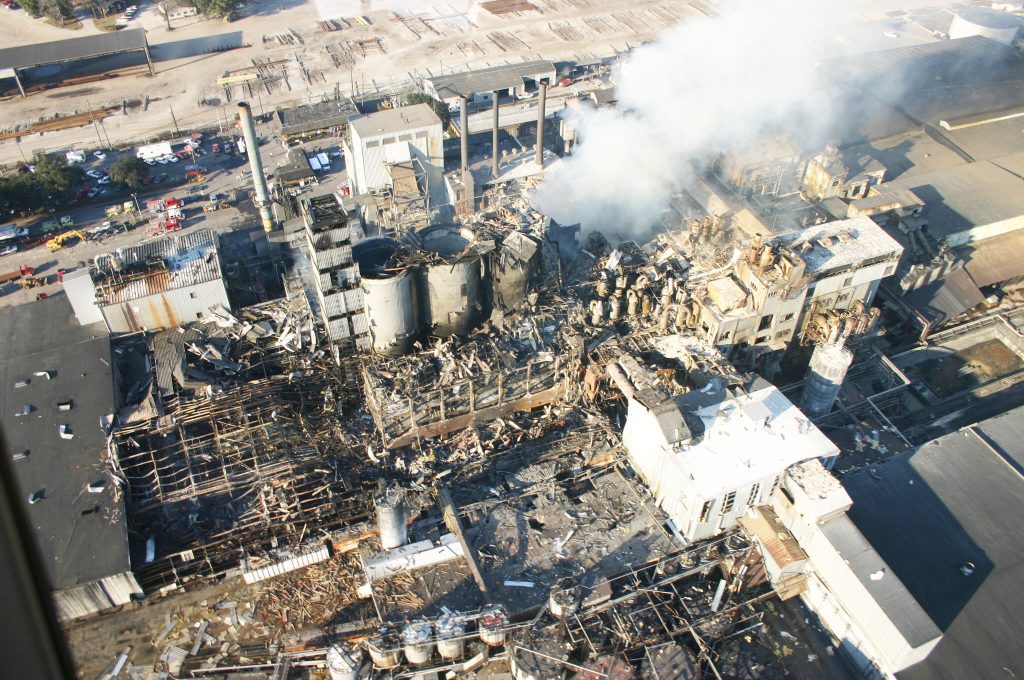
The sugar dust explosion at the Imperial Sugar Refinery is one of the clearest examples of how dangerous dust can be.
